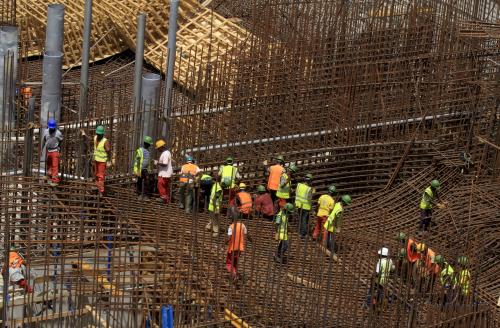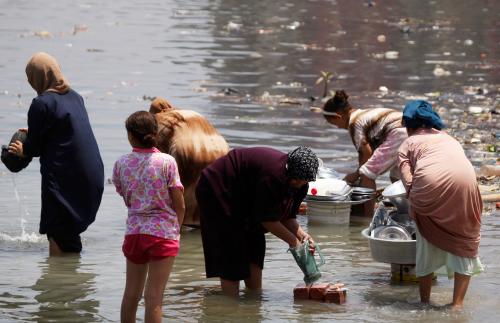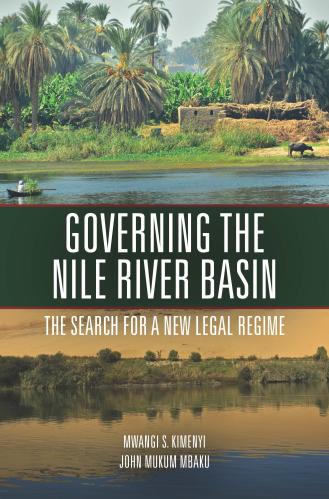The ambitious Grand Ethiopian Renaissance Dam (GERD) has been a point of contention among Ethiopia, Egypt, and Sudan in recent years. The GERD is now 70 percent complete and its reservoir expected to start being filled in the rainy season of 2020. The three countries, however, have not yet reached an agreement on the process of filling and operating it in spite of years of negotiations.
These tensions are not new: The Nile has been a cause of antagonism between Ethiopia and Egypt for centuries. The Blue Nile, which flows from the Ethiopian highlands, contributes to more than half of the annual flow of the Nile (the remaining coming from the White Nile, which flows from Lake Victoria, and Atbara/Tekeze, which also flows from Ethiopia). The rich sedimentation that is carried by the seasonal flow of the Blue Nile has been the mainstay of Egyptian agriculture for millennia. Since the times of the pharaohs, therefore, Egyptians have been wary of an upstream dam that would strangle the flow of the Nile.
Modern Egypt has used legal, political, and military means to protect its access to the flow of the Nile, the only source of fresh water for its almost 100 million inhabitants. The fact that the former prime minister of Ethiopia, Meles Zenawi, launched the GERD—which will be the largest hydroelectric dam in Africa—in 2011, when Egypt was internally fractured by a revolution, also attests to the lack of trust between the two major riparian countries.
Egypt’s claims of a historical right to the waters of the Nile have been challenged by Ethiopia and other upstream countries that demand a more equitable utilization of the river. After extensive dialogue, 10 riparian countries formed the Nile Basin Initiative in 1999; however, this multilateral approach for developing the Nile has been stalled by Egypt’s insistence to maintain a veto power on future upstream projects, though it is a part of the initiative. It is in this context that Ethiopia unilaterally launched the GERD in 2011.
The current status of the negotiations around GERD
As a hydro project, the GERD will not lead to additional water consumption in Ethiopia, but will reduce the flow of the Nile until its reservoir is filled. Thus, Ethiopia has been negotiating with the two downstream countries, Sudan and Egypt, on the pace of filling the reservoir. After failing to make progress for many years, the negotiations picked up momentum after Egypt’s President al-Sisi invited the U.S. to be a broker in November 2019. The foreign and water ministers of the three countries have held a series of meetings since December 2019 in Washington, D.C.—some of which were attended by the president of the World Bank, David Malpass, and the U.S. treasury secretary, Steven Mnuchin. The latest of these meetings came to an end without an agreement on February 13 and is expected to be followed by another round.
U.S. Secretary of State Michael Pompeo, who is visiting Ethiopia this week, is likely to make a final push to get Ethiopia to sign on to a proposed Nile Treaty. The U.S. is a major security and development ally of Ethiopia, doling out more than a billion dollars’ worth of development assistance every year. America’s significant leverage over Ethiopia could provide U.S. President Trump with a chance to push for a treaty to prove his deal-making prowess once again. In the wake of his controversial peace plan for resolving the Israeli-Palestinian conflict, President Trump might be keen to strengthen his friendship with Egypt by resolving this thorny issue.
Egypt fears that filling in the GERD’s reservoir rapidly will choke its agricultural production and is demanding to receive at least 40 billion cubic meters (bcm), out of the total 49 bcm flow of the Blue Nile. Ethiopia is pushing for a release of 31 bcm per year, and leaks from the negotiations suggest that the U.S. is proposing for allowing 37 bcm of water to flow downstream, which would enable Ethiopia to fill the GERD’s reservoir by a maximum of 12 bcm per annum. Notably, that number could be much lower due to additional conditions in the agreement that restrict storing water only to the rainy months of July and August.
This proposal is likely to cause many years of delay in the filling period of the dam’s reservoir, which has a capacity of 74 bcm, reducing its potential to generate electricity at full capacity. Moreover, this restriction could prevent Ethiopia from starting other projects along the Nile. If a drought or a new upstream project reduces the water flowing into the dam, the minimum flow would have to be maintained by drawing from the GERD’s reservoir.
Recommendations for the way forward
Prime Minister Abiy Ahmed would be better served by not promising to sign this rushed new Nile Treaty during the visit of Secretary Pompeo. It may appear next to impossible to withstand the mounting pressure from Washington, but the costs of succumbing to it will be monumental.
The main problem is that this agreement is borne out of a rushed negotiation process and may carry unintended future risks. One major source of risk is the lack of an independent, mutually accepted mechanism for monitoring and enforcing the agreement. Since any agreement on the GERD requires strong cooperation, it will have to be founded on strong buy-in from signatories to have any chance of success. The alternative is not clear, since external enforcement of the agreement and sanctioning of violations goes against international norms, and will not be practically feasible.
Moreover, a binding agreement that does not have any exit options in the context of high uncertainty is likely to create a deadlock in the future. Research shows that climate change will increase the incidence of dry and hot years in the Nile basin, which will likely reduce the volume of water in the Nile. The GERD itself requires further studies to evaluate its environmental impact, which could identify any number of contingencies related to water slippage, sedimentation, and evaporation. In the presence of so many unknowns, a close-ended agreement on a water-sharing formula is likely to create unanticipated future fallouts.
A better alternative would be to take the time to develop a comprehensive institutional framework for an integrated management and development of the Nile. The draft agreement has been sensible enough to divide the filling and operation of the GERD into two phases. Notably, there is more clarity and consensus on the first phase of filling in the reservoir (up to 595 meters above sea level), which gives Egypt, Sudan, and Ethiopia about two years of time to craft a more comprehensive cooperative framework.
Ideally, the agreement should be comprehensive enough to provide a cooperative framework for governing the GERD and other potential future projects on the Nile. It can be based on international standards for transboundary water governance and modeled after other successful examples such as the Mekong River Commission. The Nile Basin Initiative Comprehensive Framework Agreement, which has not yet received the endorsements of Sudan and Egypt, could be modified to serve as a basis for a future agreement.
This approach has several advantages over a simple water-sharing treaty. First, it will provide a platform for initiating a joint institutional mechanism for coordinating and enforcing agreements over the GERD. Second, the comprehensive framework could be designed to accommodate responses to unanticipated changes, including the coordination of future projects and climate change. The scope and conditions of future initiatives to manage, conserve, or develop the Nile could also be stipulated in advance. Finally, it will be more likely to build legitimacy for the agreement by framing the Nile issue as a challenge of managing shared rights and responsibilities rather than apportioning water quotas. The resulting sustained support for the agreement will allow it to survive political changes within signatory countries.
The countries that share the Nile must shoulder the responsibility of devising the means for sharing it equitably. Considering the complex history and scope of the Nile issue, a lasting solution can only be found in a genuine collaborative effort that recognizes the shared fate of the riparian countries. Instead of rushing into a treaty now and dealing with its consequences later, Ethiopia, Egypt, and Sudan should join shoulders to design a legal framework that advances their common long-term interest.






Commentary
Why Ethiopia, Egypt, and Sudan should ditch a rushed, Washington-brokered Nile Treaty
February 18, 2020